You might be a guest at a wedding, you might be Pakistani and have no idea what goes on, or you might just be moved by the joyful celebrations. You could notice some similarities because Indian traditions have a big influence on Pakistani wedding customs. I've attended many Pakistani weddings, and no matter how "British" the couple may be, there is always a touch of Pakistani wedding ceremonies within. However, the majority of this article focuses on Pakistani Muslim weddings.
The first interaction of both families:
In most weddings, whether arranged or unplanned, the boy's family contacts the girl's family first. Following some small conversation, the family will introduce their kid and his positive qualities, such as his desire to pursue a career and the size of his wallet. Usually, the girl's family won't have her there, but they will ask her to serve tea so they may briefly see her. There may be more than one meeting because the girl's family will typically be hesitant to agree straight away to demonstrate that they aren't giving her up so readily. Once both the boy's and the girl's families are content, the wedding is scheduled! But an official proposal is required.

Proposal
The boy's family will propose on the son's behalf and give gifts to the girls' family and mithai. A variety of Asian milk sweets is called media. Typically, the girls' side will consent, and this consent is referred to as zabaan. This is a commitment from the family that they won't break (unless it was something understandable). People frequently made promises that were later broken in exchange for a better deal.
Engagement:
Engagement parties, a ceremonial event to mark the union of the two persons, are traditionally held at Pakistani weddings in the attendance of close relatives. The bride will be approached by the groom's family to request her marriage hand. The couple now frequently exchanges rings. The cake will be sliced after prayers and blessings are read. From this point forward, everyone emphasizes the wedding day; dates are marked in calendars, and everyone gets ready!

Bestman/Bridesmaid
According to Pakistani wedding customs, a best man and bridesmaid are required. The best man and bridesmaid will be chosen by the family; they are typically close family friends and capable of supporting the bride and groom. It is customary for the Family to bring dessert because of this formal tradition.
Dholki
Before the wedding day, traditionally, women would congregate at the home of the groom to sing and dance to the sound of the dholki, a percussion instrument. It is typically hosted by various houses, each of which expresses their joy at the marriage. The plan was to create excitement before the wedding so that everyone would be invited.
The bride's family didn't typically attend or host such occasions because their overwhelming joy at 'giving' their daughter away would have created an inaccurate impression. While you can agree that the family must be joyful and upbeat, but no father wants to let go of his princess.

Mehndi
The bride will have henna applied to her two to three days before the wedding during the Henna Ceremony. The Mehndi ceremony traditionally started with a group of friends visiting the bride's house to apply mendhi; this evolved into a separate event for the male where oil was put on his head. However, since the ritual is now performed simultaneously for the bride and groom, the term "tail" has become much less common and is now more commonly used to refer to the "Mehndi" ceremony. Since so many guests are invited, this has become a primary event. The groom and bride typically dress casually on this day, though. Close family members will dress in matching sherwanis to fit the occasion's theme, which typically features yellows and greens. The majority of the night is spent with guests applying mendhi and oil to the bride and groom, though there is typically a singing and dancing between the boys and girls. The Bride wasn't expected to work in her new household until the mehndi had completely faded, as per tradition. Female guests are served mehndi cones and something sweet, usually a bag of sugar when the Mendhi function is over.
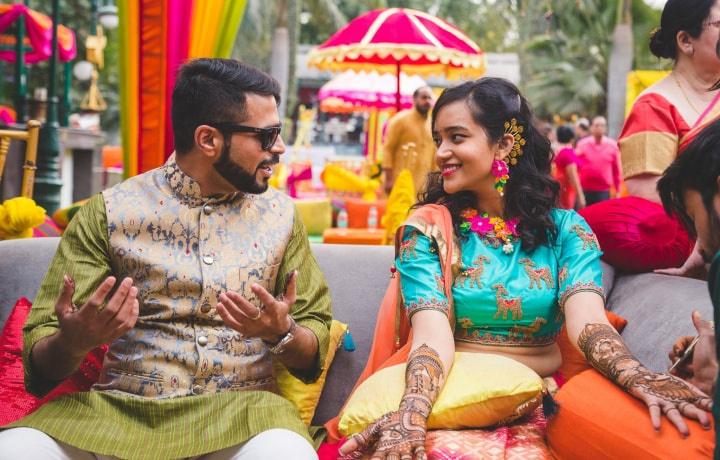

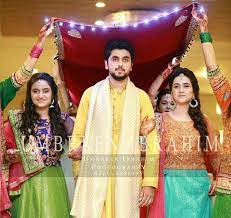

The bride and groom typically enter the ceremony on separate feet, accompanied by members of their family who will drape a scarf over them. It would be awkward for them to enter on their own, thus the primary goal is to make an entrance for them. Guests will also wrap a scarf around the mother (and grandparents) during the Mendhi. A scarf is used by guests to convey happiness since it symbolizes modesty, an elegant quality. It would be like giving a flower bouquet to someone.
To treat the bride like a princess, some families may bring her in using the customary dholi. By the Hindu custom of warding off bad luck and sending prayers to the Gods, the daughters also lead the family while carrying plates holding tea-light candles. Although it doesn't occur according to Pakistani tradition, it appears appropriate because it fits the overall tone. A few of the girls will also perform dandiya dances (decorated sticks).On the bride's or groom's wrist, the best friends from each side will also place a band. The best friends say, "I'm with you every the way while this knot is being tied," because the point of marriage is to tie the knot.
Gharoli
The bridegroom would be dressed like a Mahraj during a Gharoli ceremony held by the family the evening before the baraat (Bride Groom). The mother will start by wrapping him in a glittering scarf and placing a headband around his head. The sisters will then lead him on a stroll while alternately waving flowers (chat yah) and carrying water containers (Khara) above their heads. To keep the tempo rolling, the rest of the family may typically sing songs or call drummers. The scarf represents modesty, and the turban denotes prominence and leadership, i.e., that he is the main man. The sisters hang flowers on their brother's head because flowers stand for joy and happiness. The sister went to the well and fill up a pot (called a Khara) with water; this was a joyful task because she had the honor of preparing water for her brother's morning bath. Since this became significant and a style, most women now alternate wearing a Karah on their heads. The groom will use the remaining water for a bath and to drink the next morning.
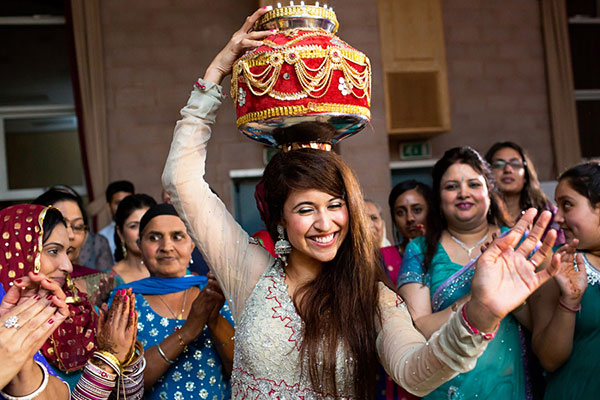
The Groom typically gives his sister money as soon as he enters the house again out of gladness. The second half of this evening comprises the relatives giving the bridegroom presents. Clothing, jewelry, and fragrance will all be included in the presents. The groom's mother and other members of the extended family frequently. receive gold rings as well.
Typically, the bride's mother will also display the Bari on this night. The Bari is a collection of presents for the bride that typically includes clothing, jewelry, housewares, and toiletries. The goal is to immediately make the Bride feel at home and ease upon her arrival.
The bride's family will typically give the pair a set of daaj, or house furnishings when they buy their own home. From a mother's perspective, she wants to make sure her daughter has all she needs for her new home.
Nikkah
The Nikkah, in which the couple signs a marriage contract, is the first significant ritual that will occur. At a minimum, two witnesses should be present, but typically, family members and close friends will be there as well. A Dowry, or financial security for the girl, will also be provided by the groom and often ranges from £200 to £5000. It is a simple, small event, but once the Imam has left, several rituals are performed:
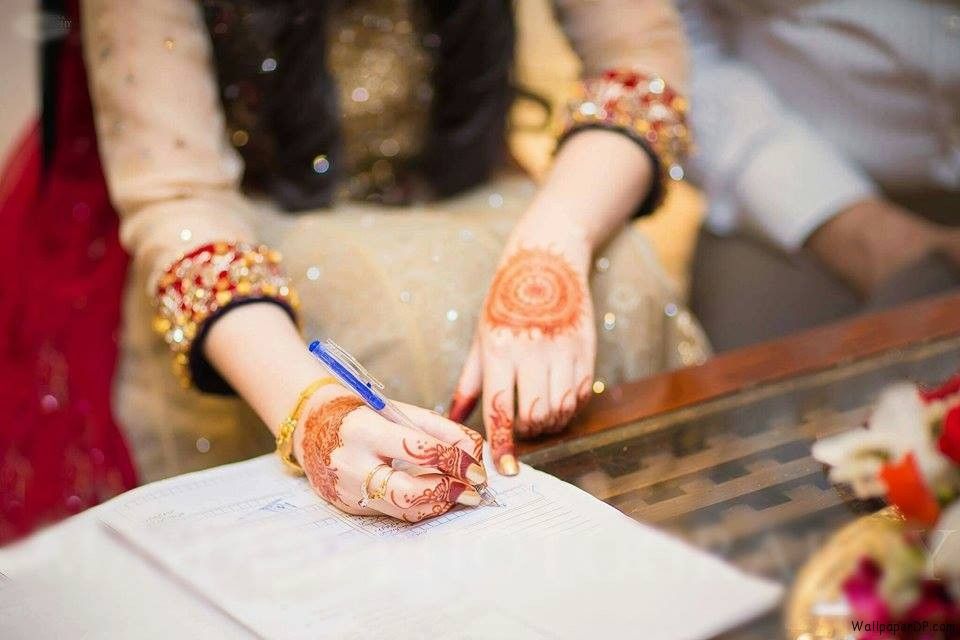
The "Unveiling the Face" ceremony is known as Munh Dikhai. The Bride is required to wear a veil and sit alongside the Husband for the first time after the Nikkah has been conducted. The Groom will make her public. Following some joyous moments, the groom and the bride will share mitai (Asian sweets) and receive congratulations from family and friends.
The girl and her family will get a choor (a scarf) from the groom's family that is filled with gifts and nutritious candies. The bride's relatives will open the choor, empty the gifts, and then add part of their presents and treats.
To signal that a wedding will take place, the bride's relatives will also throw paint on the groom's side. When the people go back to their homes, the colored clothes will serve as evidence that what just occurred.
Barat
This is yet another important role. The Baraat is "the Groom taking his family with him to pick up his Mrs." It consists of the groom's family, friends, and other colleagues making a caravan (Janj) towards the bride's home. To build excitement, drummers will be on hand, and fireworks fired off. A relative of the Grooms families familially stops the entire Baraat (Rokhana) at some point during the procession, leads everyone to their home, and provides a light snack. The Brides family will embrace the Baraatis as guests and give them a warm welcome on the other side of the fence. As Jane enters, flower garlands and rose petals will be poured upon him.

https://www.youtube.com/watch?v=QlgcJkO-NFY
Dhood Pilai: At the venue's entrance, the bride's sisters will prohibit the groom from entering until they receive enough payment. The underlying message is that "you're not getting our sister home that easy so pay up," which might result in mocking between the bride's sisters and friends and the groom's brothers and friends. When the bridegroom settles the bill, the sisters greet him with a glass of milk (Rasm-e-Dhood Pilai). Milk is a sign of purity and wealth; it was formerly compared to champagne.
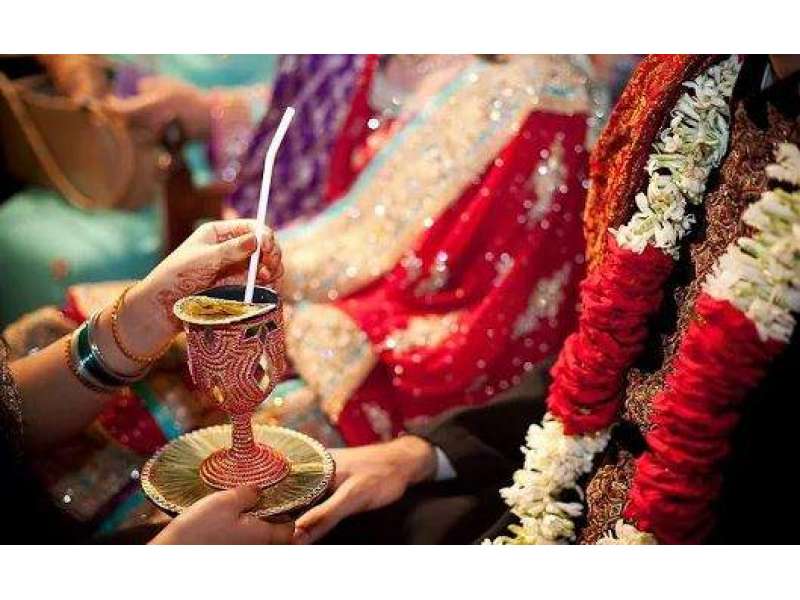
The Groom approaches his bride as soon as Janj arrives at the location, but before he can seat down, the sisters stop him once more and demand more money. The Groom pays them off and ultimately joins his wife after more joking around.

Shaadi
The Brides Reception officially begins now that the Baraat has arrived. All of her friends and family will be there to wish her well. The bride will wear a richly embroidered attire in a deep red or dark purple with matching gold jewelry, which her mother will give her as part of the Daaj, as is the custom on the Shaadi day. The groom will dress in a sherwani and turban, typically in the same color as the bride's gown. The sisters and friends will set up games to break the ice because most couples didn't know each other before the wedding. One such game is snatching the groom's shoes and demanding payment in exchange for their return. The couple can bond more quickly because of the humor and fun.
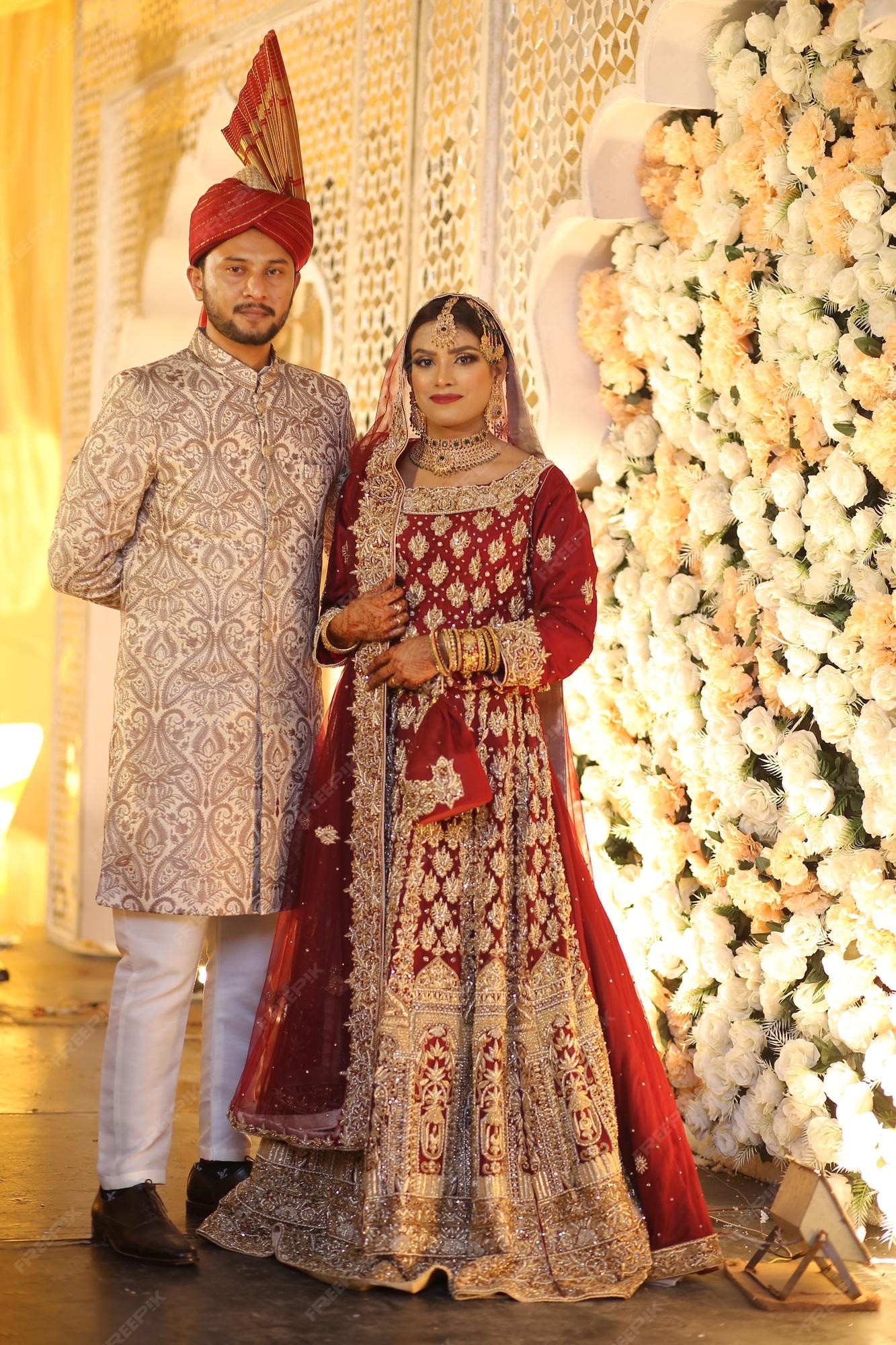
Once the visitors have been served and the girl has her extended family's spiritual support. The bride will return home so that her family can properly wish her farewell.
One of the bride's sisters will offer a plate of churi (buttered chappati) for the groom to eat when he arrives at the bride's house. This is meant to convey that the Bride is always welcome and that the Head Sister will gladly prepare meals for him.
Rukhsti:
A very emotional moment develops as the evening draws to a close and the family prepares to send the bride off because the daughter is switching families.
As the bride and groom make their way to the car, the bride will pause on her porch and hurl rice over herself. Since rice is a rich source of nutrients, it represents prosperity and productivity in Pakistan. The Bride signifies "she is leaving her mother's warmth and nurture to embark into a new family" when she throws the various grains behind her.
To bless and shield the bride as she makes her way to the car, the Qur'an is also held over her head.

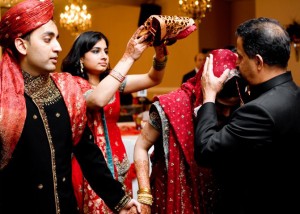
Welcome to the groom's house
The Groom's family will immediately make the Bride feel at home and encourage her once she gets there. The couple will begin by removing their friends' bracelets tied around them at the Mendhi. One of the games the family will set up involves the pair competing for a ring that is concealed in a bowl of milk. I suppose the goal is to acclimatize the couple to each other's personal space. Another activity involves the women spinning a Khara (a water pot) repeatedly around the groom's head before drinking from it. The bridegroom will make an effort to stop them. The younger brother of the bride-to-be sits on or clutches the bride's knee during the Guthna Pakrai. The Bride offers him some spending money because he is the youngest brother. Though it makes sense given that he is also her new baby brother, he will likely want cash because the practice has grown more popular.
Walima
The wedding reception, the most lavish celebration yet, is the day that everyone has been waiting for. The act of publicly announcing the marriage is also Sunnah. There aren't many customs associated with the Walima; instead, it varies depending on the household, location, timing, number of guests, etc. The bride will wear a stunning dress with jewelry donated by the groom, while the groom will often wear a fancy Western suit or tuxedo. Numerous high-end cars, a venue with a theme, a four-course meal, a DJ, a dance floor, bridesmaids, flower girls, the bridal bouquet, a wedding cake, and favor boxes are typical wedding elements.
People will say salaam and congratulate the newlyweds as they enter the stage. Most people give the bride and groom a couple of grand each rather than leaving empty-handed. But since this is now the norm, giving a small or even no donation can be uncomfortable.

Maklava
Marriages that were arranged in the past frequently resulted in the bride being unaccustomed to her new family because the parties involved were from various cities and villages. She was transported back to her parent's house on the Walima night to spend a few nights there to help her adjust to her new life and surroundings.
Honeymoon
Honeymoons are now frequently taken by newlywed couples. A week spent apart, enjoying each other's company and total privacy, brings the pair closer. In addition, it's very affordable to travel to Morocco, Turkey, and Egypt. Ladies, you'll know what you're worth.
Dinner from the bride's family for the groom's family
On the fourth day following the wedding, the bride's parents give a supper for the groom's immediate family. The first family dinner is arranged at different appropriate periods due to practical considerations.
Dawat for the new couple
To formally accept the pair as a couple, friends and relatives usually invite them over for supper. Or a sizable after-party is thrown for certain families.
Conclusion:
The Nikkah ceremony is the only legal obligation for Muslims to get married; the Walima is a Sunnah and is strongly advised. To guarantee that your marriage is recognized legally, you must also abide by local laws. This would imply that most of the customs mentioned above are not Islamic customs. Many contend that to receive the full advantages of Islam, these cultural modifications should be ignored and marriages should only include Muslims.



You must be logged in to post a comment.